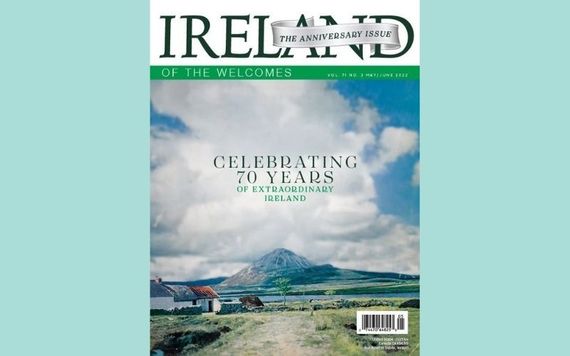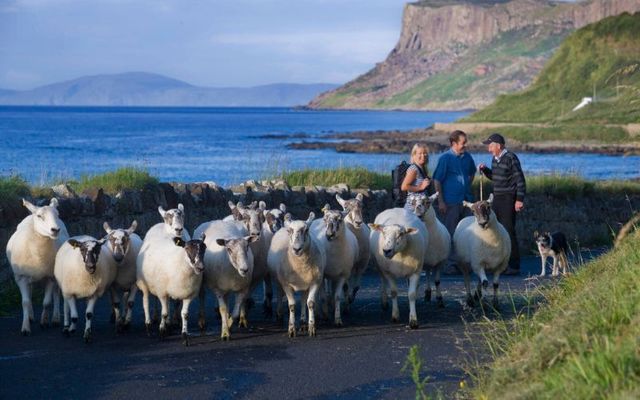Ireland has been transformed economically, socially, and culturally since the first issue of Ireland of the Welcomes was published 70 years ago. However much of what enthralled visitors back then remains true of the country today, writes Mark Henry.
Editor's note: In May 2022, our sister publication, Ireland of the Welcomes, celebrated its 70th anniversary. To mark the occasion, we dipped into our decades of archives and found incredible articles like this and others written by famous Irish figures such as Brendan Behan, Patrick Kavanagh, and Paul Henry. Author Mark Henry also provided an article reflecting on the changes in Ireland since the magazine started publication and looks at what's also stayed the same.
“In Ireland, the visitor will find comfortable accommodation, abundance and variety of food, superb sporting facilities, a varied and beautiful landscape – in fact, all the ingredients of a thoroughly enjoyable holiday. Among a friendly, warm-hearted people, he will discover that the famed hospitality of the Irish is no myth.”
So wrote Seán Lemass, the Minister for Industry and Commerce (and later Taoiseach), in the very first issue of Ireland of the Welcomes published in 1952. But despite the glossy images of beautiful landscapes that adorned the pages of the magazine, life for most Irish people at the time was grim.
It was a mere thirty years after the Irish Republic had gained independence from the United Kingdom in 1922. The industrial city of Belfast remained within the UK as part of the new state of Northern Ireland, resulting in a country that was predominately agricultural and whose agricultural exports went practically entirely to the UK.
Throughout the 1930s and 40s, the Irish government sought to realize a greater degree of independence by developing national self-sufficiency in new industries. High import tariffs were introduced to encourage people to buy local, and that resulted in a good number of British-owned firms establishing manufacturing plants here to avoid paying these on any goods they might previously have shipped over.

The anniversary issue of Ireland of the Welcomes, 2022.
A modern textile industry began to develop. Car assembly plants sprung up. Food processing factories, such Cadbury’s Chocolate, arrived. Farmers were encouraged to grow more tillage crops to reduce reliance on imports. And peat harvesting was industrialized to provide energy security.
For ordinary people, however, self-sufficiency led only to stagnation. Ireland’s economy grew by a mere 40% in the three decades up to 1952, leaving the average Irish person only half as well off as their British neighbor, and only one-third as wealthy as their American cousin.
Despite all the new industry, the number of people in jobs remained stubbornly stuck at 1.2 million just as it had been in the 1920s. Emigration was the only solution for many young people seeking work. One in every three males and females who were under the age of 30 in 1946 was destined to leave.
When they did so, their comparatively poor education levels were exposed. The United States had introduced free high school education from early in the twentieth century. The United Kingdom did so after World War II. But Ireland did not do so until the late 1960s.

Love Irish history? Share your favorite stories with other history buffs in the IrishCentral History Facebook group.
All of this meant that living conditions remained harsh for many. In the early 1950s, less than half of homes had piped water or electricity. The vast majority still had no indoor bathroom and relied on an outdoor toilet.
The government established a new body called Fógra Fáilte in 1952 to promote the country as a holiday destination overseas and to bring in more external revenue. The organization’s name translates as ‘Welcome Advertising’ in English and the publication of Ireland of the Welcomes was one of its first initiatives to reach out to would-be travelers across the water.
The recognition that Ireland needed to be more open to the world if it was to improve the living standards of its citizens gradually dawned on its political leaders. By the end of the 1950s, the decision was taken for an about-face: a total reorientation away from protectionism and towards internationalization.
Instead of import tariffs, the country would embrace free trade. Instead of focusing on production for the domestic market, it would focus on production for export markets. Instead of prioritizing local companies, it would incentivize foreign investment.
Ireland applied to join the European Economic Community – the forerunner of the European Union – in 1963, although it took a further ten years for this to come to fruition in 1973. Our fortunes were then transformed. Instead of relying overwhelmingly on the UK to buy our exports, we gained access to the largest market in the world.
The value of our goods exports leaped from €1 billion in the early 1970s to over €160 billion today. The share going to Britain fell from two-thirds to just 9%. The services we export add a further €220 billion on top of that again.
These exports generally originate from multinational companies who have located in Ireland to access the European market. Ireland has created more jobs through foreign direct investment over the past decade than practically any other European country – and the value of those jobs is the highest generated in any country in the world.
The number of people in employment finally began to grow in the 1980s as the economy expanded. Today, 2.5 million people have jobs. The greatest proportion of them are in high-skilled roles. Higher educational qualifications are, therefore, increasingly important and Ireland is one of the few countries in the world in which the majority of working-age adults now have a higher education qualification.
Incomes have doubled in real terms since we joined the EU. Our economic wealth per capita now significantly exceeds that of the UK and even pips the USA.
Our openness as a nation extends to people too. Our emigration tradition has been decisively reversed and Ireland is now a country of net immigration. Nearly one in five residents here today were born elsewhere – a figure that is higher than the US and most European nations. Instead of relying on remittances from Irish emigrants overseas to support living standards, more than $1.7 billion of remittances are now sent annually from Ireland to assist families and friends overseas.
By any reckoning, Ireland is now a very different country than it was in 1952. The United Nations rates our quality of life as the second highest in the world – behind only Norway. (The United Kingdom is ranked thirteenth, Canada is sixteenth, and the US is seventeenth.) In fact, we have risen up the rankings faster than any other developed nation – jumping 22 places in the thirty years since they started their surveys.
Ireland has finally taken her place amongst the nations of the world – indeed, amongst the leading nations of the world. She is a modern, liberal democracy. The Human Freedom Index assesses us as the fifth freest country on the planet in personal, civil, and economic freedoms. We have come a long way.

Looking for Irish book recommendations or to meet with others who share your love for Irish literature? Join IrishCentral’s Book Club on Facebook and enjoy our book-loving community.
Why has Ireland made such remarkable progress? I identify four factors that account for our comparative success in my book, "In Fact: An Optimist’s Guide to Ireland at 100".
Firstly, we have experienced stability in governance and policy direction. We are one of only a dozen countries to have been a democracy for an unbroken one hundred years. Government commitment to export-led growth, openness to inward investment, and commitment to high levels of education has remained consistent.
Secondly, that openness to the world has enabled us to attract the investment and the people we needed to flourish. Global competition has been good for us and has enabled us to learn from best practices elsewhere.
The high levels of investment in education empowered personal fulfillment and the ability of many to contribute to our national development.
Finally, our strong sense of community ensured high levels of interpersonal trust and a sense of fairness that has resulted in great equality of opportunity and a reduction in societal inequality as we have become wealthier.
While so much has changed for the people of Ireland, nevertheless, much of what was attractive to readers of Ireland of the Welcomes in 1952 remains true today.
The “friendly, warm-hearted people” that Seán Lemass wrote of are still here, powered by our open attitude and the strong sense of community that we establish with residents and visitors alike. The “varied and beautiful landscape” remains relatively untouched and, in recent years, has been the recipient of much investment to protect it and increase visitor accessibility.
Indeed those “superb sporting facilities” have witnessed the addition of many beautiful walking and cycling routes. Much of our “comfortable accommodation” has been upgraded to luxurious standards. And the “abundance and variety of food” on offer has truly never been greater and of such outstanding quality.
The Irish today have never been healthier, wealthier, or better educated. We are a people transformed, yet we remain steeped in our rich history and culture, and privileged to live on an island that may consider idyllic. Come and see for yourself.
* Mark Henry is the author of "In Fact: An Optimist’s Guide to Ireland at 100" which charts the remarkable progress Ireland has made as a nation since independence. See www.markhenry.ie.




Comments